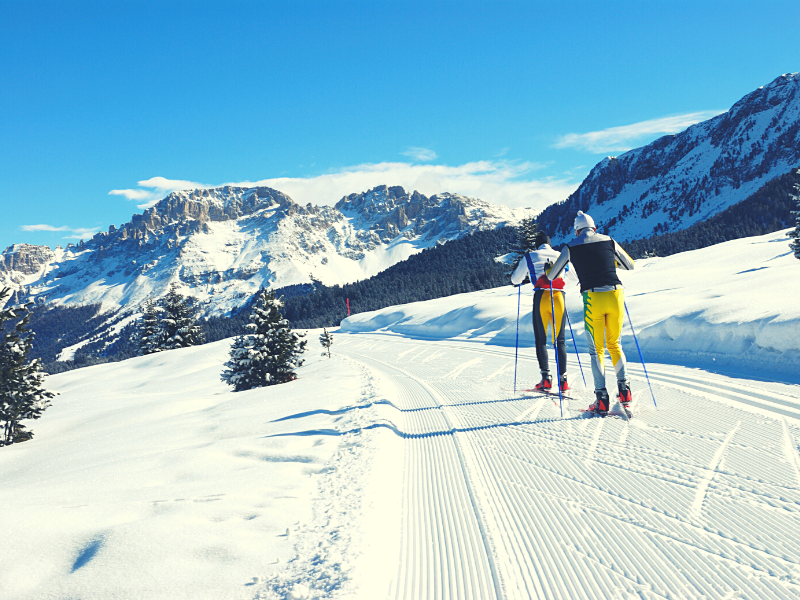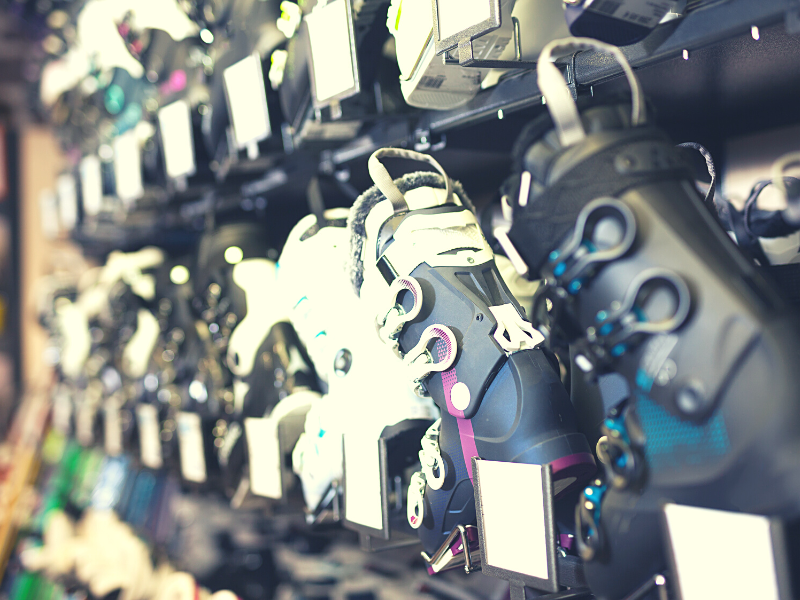Few things are as exhilarating as skiing down a steep, snowy slope. But, after a long and exhausting day of skiing, you might find that your body feels like it went through a major workout. That's because it did - and one of the reasons skiing is great for your health (and a lot of fun too.)
Skiing is a good workout because it tones your core, hamstrings, gluteals, and quadriceps. It also improves your upper body strength, flexibility, and balance. It can be a good cardio workout too. Finally, skiing keeps your mind and body active during the colder months.
That's just the tip of the iceberg though; the type of skiing you do directly impacts the type of workout you'll get and even the overall health benefits from skiing. If you're searching for ways to target certain muscle groups or specific areas of your health by skiing, you'll find the guide below incredibly valuable.
Which Type of Skiing Gives You the Best Workout?
The Cleveland Clinic notes that different types of skiing provide different types of workouts. So, for example, downhill skiing and cross-country skiing work different parts of the body and even burn different amounts of calories.
And while there are certainly more than two types of skiing, downhill and cross-country provide a great overview of the types of workouts you can get while skiing. Here's a look at how these two types of skiing impact your body and health.
Shared Health Benefits of Downhill Skiing and Cross-Country Skiing
- Improved Fitness: They both improve cardiovascular fitness, muscle strength, and flexibility
- Increased Activity in Winter: Both keep you from being passive during winter and give you the opportunity for fun exercise (instead of becoming a couch potato and only staying inside the house)
- Mental Health Benefits: They're both excellent ways to reduce stress and improve mental health - through socializing, fresh air, and being out in nature
Unique Health Benefits of Downhill Skiing
Downhill skiing is generally considered more intense than cross-country skiing, yet on average burns fewer calories. Because of its higher-impact activity, it may not be the best choice for people with joint problems. But there are still some great benefits to downhill, including:
- Tone Your Lower Body: Skiing works your glutes, hamstrings, and quadriceps more than cross-country skiing
- Build Upper Body Strength: You use your arms and upper body to help with balance and turning while downhill skiing
- Improve Balance: As you make turns, your body has to adjust and readjust to keep you balanced on your skis. This helps improve your overall balance and coordination
Unique Health Benefits of Cross-Country Skiing
Cross-country skiing is a lower-impact activity than downhill skiing but can actually help you burn more calories. It's also easier on your joints, making it a better choice for people with joint problems. But there are still some great benefits to cross-country, including:
- Tone Your Core: Unlike downhill skiing, cross-country skiing uses your core muscles more to help you balance and move forward
- Burn More Calories: On average, you'll burn 472 calories per hour cross-country skiing, compared to 354 calories downhill skiing
- Work Your Upper and Lower Body: Cross-country skiing works both your upper and lower body equally, unlike downhill skiing which focuses more on the lower body
- Improved Cardio: The constant movement in cross-country skiing helps improve your cardiovascular endurance
As you can see, both downhill and cross-country skiing offers great benefits for your health. And while they may exercise different muscle groups or burn different amounts of calories, they're both incredible ways to stay fit in the winter, while having a blast in the process.
Talking about muscle groups in terms of "upper body" and "lower body" is way too general, so let's look at which specific muscle groups are getting worked out while skiing.
Which Muscles Does Skiing Work?
Skiing is a strenuous activity that works nearly every muscle in the body, but some muscle groups get a heavier workout depending on the type of skiing. For example, downhill skiing builds leg muscles for short bursts of power, whereas cross-country skiing builds lean muscle around a person's core.
This makes complete sense - downhill skiing is more about short, sharp movements where you need explosive power from your legs, while cross-country skiing is a more constant, endurance-based activity.
Again, any type of skiing is going to put every muscle in your body through an intense workout, but main muscle groups are going to get more attention than others, and this is largely influenced by the type of skiing you do.
Let's take a closer look at a few of the main muscle groups used during both types of skiing.
Main Muscle Groups Worked by Downhill Skiing: Legs
- Hamstrings: These are the muscles on the back of your thigh and they're worked when you extend your leg behind you, which is a key movement in skiing
- Quadriceps: These are the muscles on the front of your thigh and they're worked when you bend your leg and raise your knee, which is another key movement in skiing
- Glutes: These are the muscles in your butt and they're worked when you extend your hips, which is yet another key movement in skiing
- Calves: These are the muscles on the back of your lower leg and they're worked when you point your toes and raise your heel, which is yet another key movement in skiing
Main Muscle Groups Worked by Cross-Country Skiing: Core, Chest, and Arms
- Abdominals: This is the "six-pack" muscle and it's worked when you flex your spine, which is a key movement in cross-country skiing
- Obliques: These are the muscles on the sides of your stomach and they're worked when you twist your torso, which is a key movement in cross-country skiing
- Latissimus Dorsi (Lats): This is the muscle on the side of your back and it's worked when you pull your arms back, which is a key movement in cross-country skiing
- Pectorals: These are the muscles on the front of your chest and they're worked when you push your arms forward, which is a key movement in cross-country skiing
- Triceps and Biceps: These are the muscles on the back and front of your upper arm, respectively, and they're worked when you extend and flex your arms, an integral movement of the double-pole technique
As you can see, the main muscle groups worked by each type of skiing are quite different. Downhill skiing focuses more on the leg muscles, while cross-country skiing focuses more on the core muscles and upper body.
Skiing is an excellent way to work out your whole body, no matter which type you choose. And because it's such a fun activity, you may not even realize how much of a workout you're getting.
Since any type of skiing is so great at working muscle groups, surely you'd get in shape from it, right? The answer's a bit complicated and has a giant caveat.
Can You Get in Shape From Skiing?
Skiing is a full-body workout that can keep you toned and healthy if you do it regularly. However, certain muscles are used less frequently when skiing and may need to be exercised separately. For example, downhill skiing primarily works out leg muscles but neglects some of the upper body.
Some people wonder if skiing can serve as a substitute for going to the gym and if skiing can whip them into shape. If the definition of "in shape" is "fully exhausting every muscle group," then the answer would be no.
You'd need to supplement some of the neglected muscle groups through a different form of exercise.
That's not to say that skiing isn't a full-body exercise, because it is. It's just that certain muscles are used as much compared to going to the gym and isolating that muscle group and exercising it to exhaustion.
On the other hand, one could argue that skiing gives you a better workout because your muscles all get to work together in a “natural” way and not through a set of artificial exercises.
There's a lot to like about skiing, even if it may not be the silver bullet for going to the gym. Here are a few of the standouts:
Skiing Works All Your Muscles
It doesn’t matter how many times you’ve skied the same slope, you can always be assured that the next time you shred that snow, it’ll be a new experience, and the next day you'll feel the burn.
Thanks to this variety, you can work some of your smaller sets of muscles that you didn’t even know you had! From moguls to carving, every skiing experience is different, and your muscles have to adjust on the fly.
Heart Health Benefits
Just as important – if not more so – is the heart health benefits that skiing provides.
Not only does skiing get your heart pumping faster, but it also works as interval training because most people will ski at a variety of different speeds and intensities. This allows your heart rate to speed up and slow down, which is great for your heart health.
As your heart pumps faster during this interval training, the stronger your heart will also become. Your endurance will improve as a result and you’ll find that you can tackle larger and larger slopes if you ski regularly.
Burn Those Calories!
Of course, getting in shape also means burning calories and shedding those extra pounds you could do without. Every type of skiing is a great way to burn calories and in the opinion of one, far more exciting than hitting the treadmill for an hour.
Skiing vs. Running: Which is the Better Workout?
Running is an extremely common workout that provides several health benefits - but how does it compare to skiing? Since skiing is so multi-faceted, it's best to compare the different types of skiing to running - this gives a more accurate idea of which is the better exercise.
The good news is that an hour of Nordic cross-country skiing is comparable to an hour and 15 to 20 minutes of running. And, if you're doing an aerobic workout like running, it's important to maintain a heart rate of at least 60% to 80% of your maximum. When you ski, your heart rate will be about the same as it would be if you were running.
Downhill skiing, on the other hand, isn't as effective for aerobic exercise as cross-country skiing, so it's not necessarily the best to compare to running. It's more appropriate to compare downhill skiing to rowing or cycling.
Alpine skiing and cross-country skiing can help with marathon training and trail running by making the body more flexible. So, when you get back to trail running after the winter, the transition will be a lot easier when you’ve been skiing than if you’ve just been hitting the gym – or worse, simply sitting on the couch!
Skiing Provides Major Physical Benefits
By looking at the facts surrounding skiing and the type of workout it provides, it becomes clear that skiing holds many physical benefits – even for beginners. Among others, skiing improves your flexibility, mobility, balance, muscle tone, and heart health.
While you may be a bit stiff at first because you’re using muscles that you’ve never used before, or haven't stretched in a long time, the freedom that you can find on the slopes is definitely worth it!
Skiing Also Holds Major Mental Health Benefits
The mental benefits of skiing are just as important as the physical ones. Skiing can improve your mental and emotional health, providing you with a much-needed boost. When you're on the slopes, you can both socialize and have periods where it's just you and the mountain.
These moments alone offer a chance to clear your head and appreciate nature.
Being in nature has been shown to boost mental health, and it doesn't even require exercise! Just being outdoors provides stimulation and energy. This is especially crucial during the winter months.
While skiing may not solve all your problems, like that weird Thanksgiving meal in the 90s (nothing can help with that awkward conversation,) it can be a great way to forget about your troubles – even if it’s just for a day.
Skiing is an excellent way to reduce stress and anxiety, providing an outlet for all that built-up tension you've been carrying around. It's also a great way to socialize, as you can hit the slopes with friends or family.
And, if you're someone who loves a challenge, skiing can provide that as well. You can challenge yourself to ski better, faster, and longer each time you hit the slopes.
Skiing is Fun, With a Side of Exercise
While this entire article is focused on the health benefits of skiing, you can't lose sight of what the activity is really about, and that's first and foremost having fun in nature during the winter.
You can find a sense of peace and tranquility on the slopes that you may not find anywhere else. When you're skiing, you're living in the moment and enjoying the ride.
Winter is often seen as a dreary time when there’s not much to do but sit inside. So getting outside and skiing can do wonders for your physical and mental well-being.
So, instead of just watching the Winter Olympics or checking out videos on YouTube, try hitting the slopes yourself. Grab some fresh air and vent the stress from your daily life.
The byproduct will be an awesome workout to boot.



